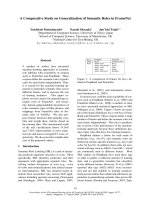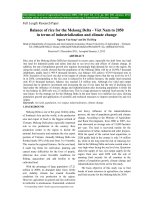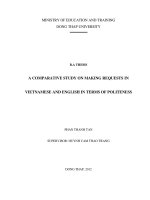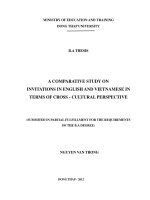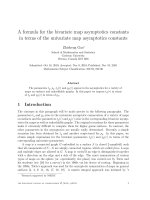Free online translators a comparative assessment in terms of idioms and phrasal verbs
Bạn đang xem bản rút gọn của tài liệu. Xem và tải ngay bản đầy đủ của tài liệu tại đây (505.21 KB, 5 trang )
Free Online Translators: A Comparative Assessment in Terms of Idioms and Phrasal
Verbs
[PP: 15-19]
Marziyeh Taleghani
Faculty of Literature and Foreign Languages, Islamic Azad University
South Tehran Branch, Tehran, Iran
Ehsan Pazouki
Department of Computer Engineering & Artificial Intelligence
Shahid Rajaei Teacher Training University
Tehran, Iran
ABSTRACT
Free online translators are in fact statistical machine translators that create translator models
using parallel corpora. Although it’s not a new subject and many works are reported on that in recent
years, it still suffers from lots of shortcomings and has a long way ahead. While the literature on
machine translators is vast, there are only a few that evaluate free online machine translators in specific
terms like idioms. The aim of this paper is to evaluate and compare four free online translators in terms
of translating English idioms (including idiomatic phrasal verbs) into Persian. To that end, ten chosen
texts from the book “oxford word Skills: idioms and phrasal verbs” were translated by four online
and
translators, www.bing.com, www.translate.google.com , www.freetranslation.com
www.targoman.com , and the obtained results were compared in a subjectively method based on
Aryanpur English to Persian dictionary. Comparison of the results shows that www.targoman.com has
a better performance in translating idioms from English to Persian and as a result, it can be the best
choice if the aim is to do so.
Keywords: Machine Translation, Idioms, Phrasal Verbs, Online Translator
The paper received on
Reviewed on
Accepted after revisions on
ARTICLE
INFO
12/12/2017
12/01/2018
24/03/2018
Suggested citation:
Taleghani, M. & Pazouki, E. (2018). Free Online Translators: A Comparative Assessment in Terms of Idioms and
Phrasal Verbs. International Journal of English Language & Translation Studies. 6(1). 15-19.
1. Introduction
Machine translation (MT) whose aim is
to use software in order to translate texts is a
subgroup of computational linguistics.
Although it’s not a new subject and many
works have (Shao, Sennrich, Webber, &
Fancellu, 2017 ; Guzmán, Joty, Màrquez, &
Nakov, 2017; Kais A. Kadhim, Luwaytha S
Habeeb, Ahmad Arifin Sapar, Zaharah
Hussin, & Muhammad Muhammad Ridhuan
Tony Lim Abdullah, 2013, Crabbe & Heath,
2017; Harrat, Meftouh, & Smaili, 2017)
been done on that, it still suffers from lots of
shortcomings and has a long way ahead.
We have different approaches to
machine translation: rule-based approach,
statistical
approach,
example-based
approach and Hybrid MT. the first approach
involves more information about the
linguistics of the source and target
languages, using the morphological and
syntactic rules and semantic analysis of both
languages(“wikipedia,” 2018) and is mainly
used in the creation of dictionaries and
grammar programs while the others try to
generate translations using statistical
methods based on parallel corpora.
On a basic level, MT performs simple
substitution of words in one natural
language for words in another, but that alone
usually cannot produce a good translation of
a text because recognition of whole phrases
and their closest counterparts in the target
language is needed. Solving this problem
with corpus and statistical techniques is a
rapidly growing field that is leading to better
translations, handling differences in
linguistic typology, translation of idioms,
and the isolation of anomalies.(Albat,
Thomas Fritz, 2012)
Although in recent years many works
are reported on evaluation of machine
translation (Chunyu Kit & Tak Ming Wong,
2008),(Goyal & Lehal, 2009),(Mitra
Shahahbi, 2009), some of which use
automatic evaluation systems(Kais A.
Kadhim et al., 2013),(Mohammed N. AlKabi, Taghreed M. Hailat, Emad M. AlShawakfa, & Izzat M.Alsamadi, 2013),
(Guzmán et al., 2017), (Shao et al., 2017)
International Journal of English Language & Translation Studies (www.eltsjournal.org)
Volume: 06
Issue: 01
ISSN:2308-5460
January-March, 2018
most of them have just evaluated the quality
of the whole texts considering terms like
explicitness, clarity, fidelity, accuracy or
intelligibility(Claire Ellender, 2012),(Goyal
& Lehal, 2009) and only a few of them have
worked on specific terms like register, lexis
or idioms, just to name a few,(Stephen
Hampshire & Carmen Porta Salvia, 2010).
So it seems that more works are necessary to
be done in these domains.
Free online translators are in fact
statistical machine translators that use
corpora in order to translate texts. The aim
of this paper is to evaluate and compare four
online translators in terms of translating
Idioms (including Idiomatic phrasal verbs).
An idiom is a combination of words in
common use, including some phrasal verbs,
which have a figurative meaning. Since the
meaning of idioms cannot be understood
from the superficial meanings of the single
words constituting them, so there are some
problems in both processes of understanding
and translating them(Amir Shojaei, 2012).
When translating an idiom we
may(Chiara Grassilli, 2013):
1. Try to find an idiom in the target language
which uses the same words, the same
structure and has the same exact meaning.
This is the top notch solution, but you often
will not find it.
2. Try to find an idiom in your language
which uses different words, but has the same
structure and the same exact meaning.
3. Try to find an idiom in your language that
has different words, different structure but
the same exact meaning.
4. Try to find an idiom in your language that
has different words, different structure and a
slightly different meaning, and complete it
with a short explanation.
Idiomatic translation is a key factor in
quality of the statistical machine translation
output. As automatic evaluation metrics are
not efficient tools in assessing the quality of
idiomatic terms. Therefore, subjective
evaluation is the better approach.
In order to conduct the research first,
according to the paper’s desires (the text
length and available languages) four target
online
translators,
www.bing.com
,
www.translate.google.com
,
www.freetranslation.com
and
www.targoman.com were chosen among
translators that were proposed machine
translation page of Wikipedia. Then the
sample texts were chosen from book
“Oxford Word Skills: Idioms and Phrasal
verbs” using the systematic sampling
method. In the next step the English source
texts were given to the target online
translators and the results were obtained.
Then Meaning of the idioms in translated
texts was compared to the correct meanings
according to Aryanpur English to Persian
dictionary and results were collected. At last
the target online translators were ranked
according to their performance in translating
idioms from English to Persian. (Appendix
1)
2. Design of the Study
2.1 Research Question and Hypotheses
Although machine translation is not
considered as a new subject in translation
domain, it couldn’t win the place which
deserves due to some major problems. Only
in recent years machine translation has
gotten settled as part of the translation
world.
As it was mentioned, online translators
are examples of statistical machine
translation which works based on parallel
corpora. Nowadays there are many online
translators which are designed to translate in
different languages based on different
corpora among which there are some that
can translate from English to Persian.
One of the main problems of MT is
detectable when it comes to translate idioms
(a combination of words in common use,
including some phrasal verbs, which have a
figurative meaning.)
The question that arises here is how
successful online translators perform in
translating idioms.
Here in this paper four online translators
are chosen and compared in terms of
translating idioms and the purpose is to find
which one performs the best?
2.2 Choosing Translators
In order to find the ultimate online
translators this paper tried the list of online
translators presented in machine translation
page of Wikipedia. The list consists of
fifteen online translators among which the
translation.babylon.com was filtered so
unavailable. Since the purpose was to
compare online translators in terms of
translating idioms from English to Persian
the translators that didn’t have the
possibility of translating in to Persian were
crossed out and the list ended up in 8 online
translators.
As we were looking for translators that
were able to translate long texts, in the next
step we crossed out those who had
limitations for the number of the words in a
text and got the list of five online translators.
Table 1: List of Ultimate Translators
Cite this article as: Taleghani, M. & Pazouki, E. (2018). Free Online Translators: A Comparative Assessment in
Terms of Idioms and Phrasal Verbs. International Journal of English Language & Translation Studies. 6(1). 15-19.
Page | 16
Free Online Translators: A Comparative Assessment in Terms of…
Further
checks
showed
that
www.bing.com
and
www.freetranslations.org
use the same
datasets and as a result their translations are
exactly the same so we chose one of them,
www.bing.com and came to the final list of
four translators.
2.3 Sampling
As the focus of the paper is on
comparing online translators in terms of
translating idioms, texts were needed that
include a wide range of idioms in English.
So the book “oxford word skills: Idioms and
Phrasal Verbs (Intermediate)” was chosen as
the source of the texts. The book is consists
of 60 separate lessons, each lesson focusing
on a group of Idioms through one or more
texts.
In the next step, based on the
assumption than 10 lessons out of 60 could
be a good representative, through systematic
sampling 10 target texts were chosen. In
order to perform systematic sampling first
we divided 60 by 10 and reached the interval
of 6, then randomly chose a number among
1 to 6 (we put each number on a piece of
paper and chose among them), which was 2,
and the sample text numbers which were: 2,
8, 14, 20, 26, 32, 38, 44, 50 and 56 were
obtained.
I decided beforehand that if a lesson was
consist of more than one page just the texts
of the first page be included in the research.
Concentrating on the chosen texts, I
realized that lesson 56 just focuses on
phrasal verbs and no idiom of other sorts is
included so we changed it to lesson 55.
2.4 Research Procedures
In order to conduct the research, first the
texts of the chosen lessons were typed then
each text was given to each translator
separately and the translations were
obtained. Obtained results of each translator
were saved separately.
2.5 Assessing the Outcomes
There were all in all 110 idioms in the
selected texts. We first find the definition of
Marziyeh Taleghani & Ehsan Pazouki
these idioms according to Aryanpur English
to Persian dictionary, 5 idioms were omitted
in this stage as no matches were found for
them. So we came to the total number of
105.
Then looking at the definitions made by
each translator in the translated texts the
accurate definitions were found and the
number of correct translations was
calculated. Finally, the percentage of correct
answers for each translator was calculated.
(appendix 1)
Here some examples of the translations
of each translator are presented.
Table 2: Examples of Translations of the idioms
by Google Translator
Table 3: Examples of Translations of the idioms
by Targoman
Table 4: Examples of Translations of the idioms
by Free Translation
Table 5: Examples of Translations of the idioms
by Bing
3. Results and Discussion
The obtained results of each translator
are gathered in a table (appendix 1) where
International Journal of English Language & Translation Studies (www.eltsjournal.org)
Volume: 06
Issue: 01
ISSN:2308-5460
January-March, 2018
Page | 17
International Journal of English Language & Translation Studies (www.eltsjournal.org)
Volume: 06
Issue: 01
ISSN:2308-5460
January-March, 2018
the initial word of the name of each
translator represents that.
As the results show Targoman has
translated 21 idioms out of 105 correctly
which means 20 percent of the whole where
Google translator, free translation and Bing
translator each respectively translated 19, 14
and 11 Idioms correctly which means
18.09%, 13.33% and 10.47% of the whole.
As you can see the results demonstrate
that Targoman performs the best when it
comes to translate idioms from English to
Persian which was somehow predictable
beforehand as this translator is specialized in
translating English to Persian and V.s; in
fact it is bilingual while the other translators
in this research are multilingual. It worth
mentioning that Google translator stands in
second place with a small difference from
Targoman which was also predictable as
Google translator is supported by Google
company which has powerful search engines
and as a results has access to various, up to
date, vast corpora.
The result of this study brings about two
implication. The first implication is that the
online translators’ users who wants to get
the best results in idiomatic translation must
use dedicated bilingual tools such as
Targoman translator or tools that is a vast
idiomatic parallel corpora such as Google
translator. The second implication of the
study is that the online translators’ designers
must apply more specialized corpora in this
domain concerning a vast number of idioms
and phrasal verbs to improve their function.
Figure 1: Percentage of the Correct Translation
of Online Translators
4. Conclusion
The purpose of this paper is to evaluate
and compare four online translators in terms
of translating English idioms into Persian.
For this purpose 10 English texts from the
book “Oxford Word Skills: Idioms and
phrasal verbs” were chosen and translated
by these four online translators. After
studying the Idioms and their corresponding
translations the number of correct
translations was obtained. The obtained
results demonstrate that Targoman performs
the best in terms of translating Idioms from
English to Persian so it is the best choice
when our aim is to do so.
References
Albat, Thomas Fritz. (2012). Systems and
Methods for Automatically Estimating a
Translation Time. US Patent Application
Publication 0185235.
Amir Shojaei. (2012). Translation of Idioms and
Fixed
Expressions:
Strategies
and
Difficulties. Theory and Practice in
Language Studies, 2, 1220–1229.
Chiara Grassilli. (2013, October 25). How To
Translate
Idioms.
Retrieved
from
/>Chunyu Kit, & Tak Ming Wong. (2008).
Comparative Evaluation of Online Machine
Translation Systems with Legal Texts. Law
Library Journal, 100:2, 299–321.
Claire Ellender. (2012). Free Online Translators:
A
Comparative
Assessment
of
www.worldlingo.com,
www.freetranslation.com,
and
www.translate.google.com.
Translationjournal, 16.
Crabbe, S. & Heath, D. (2017). Creating a
Translation Glossary Using Free Software:
A Study of Its Feasibility with Japanese
Source Text. International Journal of
English Language & Translation Studies.
5(3). 151-160.
Goyal, V., & Lehal, G. S. (2009). Evaluation of
Hindi to Punjabi Machine Translation
System. IJCSI International Journal of
Computer Science Issues, 4, 36–39.
Guzmán, F., Joty, S., Màrquez, L., & Nakov, P.
(2017). Machine translation evaluation with
neural networks. Computer Speech &
Language,
45,
180–200.
/>Harrat, S., Meftouh, K., & Smaili, K. (2017).
Machine translation for Arabic dialects
(survey). Information Processing &
Management.
/>Kais A. Kadhim, Luwaytha S Habeeb, Ahmad
Arifin
Sapar,
ZaharahHussin,
&
Muhammad Muhammad Ridhuan Tony Lim
Abdullah. (2013). An Evaluation Of Online
Machine Translation Of Arabic Into English
News Headlines: Implications On Students’
Learning Purposes. TOJET: The Turkish
Online Journal of Educational Technology,
12(2), 39–50.
Mitra Shahahbi. (2009). An Evaluation of
Output Quality of Machine Translation
Program. In Student Research Workshop,
RANLP (pp. 71–75). Borovets, Bulgaria.
Mohammed N. Al-Kabi, Taghreed M. Hailat,
Emad
M.
Al-Shawakfa,
&
Izzat
M.Alsamadi. (2013). Evaluating English to
Arabic Machine Translation Using BLEU.
(IJACSA)
International
Journal
of
Cite this article as: Taleghani, M. & Pazouki, E. (2018). Free Online Translators: A Comparative Assessment in
Terms of Idioms and Phrasal Verbs. International Journal of English Language & Translation Studies. 6(1). 15-19.
Page | 18
Free Online Translators: A Comparative Assessment in Terms of…
Marziyeh Taleghani & Ehsan Pazouki
Advanced
Computer
Science
and
Applications, 4, 66–73.
Shao, Y., Sennrich, R., Webber, B., & Fancellu,
F. (2017). Evaluating Machine Translation
Performance on Chinese Idioms with a
Blacklist Method. CORR, abs/1711.07646.
Stephen Hampshire, & Carmen Porta Salvia.
(2010). Translation and the Internet:
Evaluating the Quality of Free Online
Machine Translators. Quaderns., 17, 197–
209.
wikipedia.
(2018).
Retrieved
from
/>ation
International Journal of English Language & Translation Studies (www.eltsjournal.org)
Volume: 06
Issue: 01
ISSN:2308-5460
January-March, 2018
Page | 19


